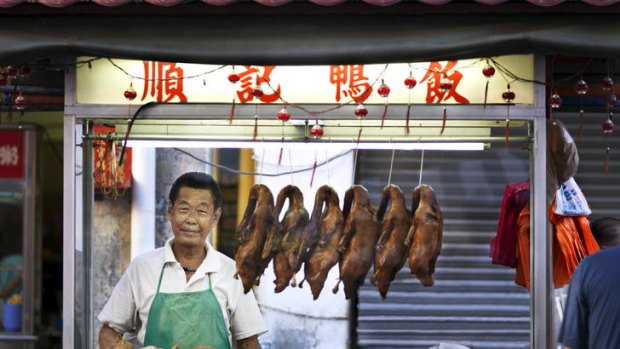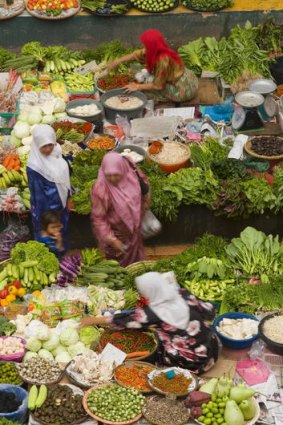
Eclectic tastes ... a street vendor.Credit: Getty Images
Sally Webb shops, cooks and dines to unlock the flavours of a sizzlingly diverse cuisine.
POULTRY sellers Ghani and Mohammed are playing to the crowd.
It's 8am at the Chowrasta Wet Market in George Town, the historic and cultural heart of the Malaysian island of Penang, and we're shopping for ingredients to cook a local-speciality fish noodle soup, Penang asam laksa.

A street market.Credit: Getty Images
Alex, one of my travelling companions in our small group of journalists, is feeling a little squeamish and says she'd like something rather than fish in her soup. "That's fine, we'll get you some chicken," says our guide, Nazlina Hussin, who's taking us through the busy market while she picks up ingredients for the dish she'll later teach us to make.
She moves towards the poultry stalls after gathering ikan kembung (fusilier) fish, which she says will be perfect for our soup.
Ghani and Mohammed, dressed in matching floor-length plastic aprons splattered with blood, seize the moment: the former takes a live chicken from a pen and stretches its neck while the latter cuts off its head with a single theatrical slash of his knife. The two men pose proudly for photos, holding the bleeding carcass by its feet. We're all shocked, a few of us squeal; Alex turns a pale shade of green.
Fortunately, the rest of the market is not quite so confronting.
Typical of many Asian wet markets, it's noisy and occasionally smelly. The chickens are the only live species we see but there are plenty of meat carcasses being butchered and a complete lack of refrigeration. The market is bustling with shoppers. Stallholders proudly display their wares: exotic vegetables, fruit and spices including ginger flowers, turmeric and galangal, sacks of dried fish, mounds of chillies and vibrant buckets of viscous red-chilli paste.
A team of wizened old men grind coconut flesh from husks before pressing it twice to extract the fresh milk, which is sold in clear plastic bags tied with rubber bands. At one end of the market, grocers sell luminously bright pickled vegetables (artificially coloured, I later learn) and myriad varieties of belacan, the pungent fermented shrimp paste that's a quintessential ingredient in many of Malaysia's most famous dishes.
Ingredients gathered, Nazlina leads us to the Eastern & Oriental Hotel, where our cooking class will take place. Founded in 1885 by the Sarkies brothers, who also built Raffles in Singapore and The Strand in Rangoon, it fell into decline in the mid-'90s and closed, reopening a decade ago after a major renovation.
The hotel's illustrious guests have included Noel Coward, Somerset Maugham and Rudyard Kipling. I'm not sure what those esteemed literary figures (or current guests, for that matter) would have made of the simmering woks and burners, chopping boards and pestles and mortars that Nazlina and her helpers set up on a covered terrace overlooking the Straits of Malacca. Indeed, this outdoor kitchen seems out of place amid the faded white colonial splendour of the hotel.
However, we're soon engrossed in our tasks. Guided by Nazlina, we scale and gut fish, make stock, boil noodles and pound chillies with belacan, turmeric, galangal, lemongrass, ginger and shallots. Although it's a relatively humble Nyonya dish, Penang asam laksa is surprisingly complex and time-consuming to prepare, taking our small army of a dozen cooks, plus Nazlina and her helpers, more than two hours. It differs notably from the more familiar curry laksa because it doesn't use coconut milk.
The end result – an aromatic, complex fish noodle soup laced with the sourness of tamarind, sweet pineapple and fragrant fresh herbs – is delicious.
Nyonya dishes such as asam laksa are the result of the intermarriage between local Malays and Chinese immigrants who settled in the straits region, including in Penang, Malacca and Singapore. Nyonya is just one of several culinary styles that make up Malaysia's ethnically diverse cuisine.
During our week-long visit, starting in Kuala Lumpur then travelling via the island of Langkawi to Penang, we eat a plethora of traditional Malay, Malaysian Indian (also known as mamak) and Malaysian Chinese food, as well as plenty of Nyonya dishes. We're also learning to cook these dishes – Nazlina's cooking class is our third in five days – which we hope will give us a handle on exactly what defines Malaysian food.
In Kuala Lumpur, a few days earlier, we spent a morning at the highly regarded LaZat cooking school at Petaling Jaya, a genteel residential suburb south-west of central Kuala Lumpur, under the tutelage of Ana Abdullah and her friendly staff, who guided us through demonstrations of preparing and cooking cucur udang (prawn fritters), acar timun (spicy cucumber salad), onde onde (palm sugar in glutinous rice) and, possibly Malaysia's best-known dish, beef rendang.
The latter is traditionally prepared for festive occasions and usually in large quantities. Cooked slowly for several hours, it is intensely aromatic, complex, spicy and ever so slightly sweet. The secret ingredient, we discover, is kerisik, grated fresh coconut dry-fried in a wok then pounded to release its oils, added as a finishing touch. Although much of the preparation is done for us – ginger, shallots and garlic peeled, ingredients measured out – LaZat's recipe cuts no corners and the results, which we devour for lunch, are divine.
On the island of Langkawi our cooking class takes place in a traditionally built wooden Malay home. Our teacher, Shuk, runs a Langkawi restaurant popular with foreigners. In his black taqiyah cap, he looks like the poster child for authentic Malaysian cooking. Ironically, though, his cooking class advocates every short cut imaginable, including using food processors to blend spices and pastes rather than a mortar and pestle and preparing pastes in large quantities that can be frozen in batches for later use. On the one hand it seems practical for busy home cooks; on the other, the dishes we cook – beef rendang, gulai ayam (chicken curry), ikan bakar (baked fish in banana leaf), chilli sambal and Chinese-style stir-fried vegetables – lack the intense, distinctive flavours of dishes we prepare traditionally.
A common subject in each of our classes, though, is the importance of belacan. If there's a single most important ingredient on the Malaysian peninsula, this salty, smelly shrimp paste, dried in the sun and pressed into blocks, has to be it. Nazlina calls it "Malaysian butter".
When wrapped in foil and toasted in a wok or roasted in the oven, the paste dries out and can then be crumbled into dishes.
Also ubiquitous in Malaysian cooking are sambals: chilli-based sauces used as condiments. The Malay sambal belacan, combining toasted belacan with chillies, sugar and lime juice, is one of the most common. Shuk tells us that the ability to make a good sambal is considered a necessity for all Malaysian housewives and potential brides are often tested by their prospective mothers-in-law to make sure they pass the sambal test.
As far as Malaysian street food is concerned, it's hard to go past char kway teow, flat rice noodles stir-fried with soy sauce, prawns, cockles, bean sprouts, egg, Chinese chives and occasionally Chinese sausage. There are probably as many versions of it as there are Malaysian grandmothers – variations include beef, chicken, duck or vegetable char kway teow – but it's commonly accepted that the Penang version is the purest.
One of the great joys of travelling through this culturally and ethnically diverse country is enjoying the variety of its culinary delights, whether it's from the hawker stalls that line Kuala Lumpur's famous Jalon Alor, or a charming rustic eatery such as Nam at Bon Ton Resort on Langkawi, where we enjoy typical Nyonya dishes including prawns in pandan leaf, tamarind fish and pineapple acar served on a banana leaf platter.
However, it's Penang that provides the best food moments of the trip, epitomising the diversity of Malaysia's food.
We get our mamak fix at Restoran Kapitan, in the heart of George Town's Little India, which is lined with stores selling sari fabric and packets of glittery bangles. Open 24 hours, Kapitan is famous for its tandoori chicken, served with light naan, sweet soy, chicken curry gravy and a sensational mint sauce with green chilli, garlic and green mango. The dishes won't win any awards for presentation but are packed with flavour.
Also in George Town, we feast on Chinese and Nyonya food at Tek Sen restaurant. With metal stools and tables covered in plastic sheeting, its decor is fairly basic but it serves some of the best food in Penang, including double-fried roasted pork with chilli and sweet soy, stir-fried clams with fermented bean sauce and basil, and gulai tumis, a spectacular hot and sour Nyonya tamarind fish curry.
Before our market visit with Nazlina, we have breakfast at nearby Line Clear, one of Penang's most popular mamak hawker stalls and which, according to the sign above its rickety laneway tables, has been going strong since 1930.
Nasi kandar (rice served with a selection of curries and vegetables) is the lunchtime favourite here but I'd return any day for the light and flaky roti canai cooked to order by Mr Saib, who deftly scrapes and folds the flat-bread batter across a sizzling hotplate.
Filled with egg and onion and accompanied by cups of sweet, milky ginger tea, it's one of the most delicious things I eat during my time in Penang and the perfect start to the global culinary journey that is any day in Malaysia.
The writer was a guest of Tourism Malaysia and Malaysian Airlines.
Trip notes
Getting there
Malaysia Airlines flies from Sydney to Kuala Lumpur. 13 26 27, malaysiaairlines.com.
Staying there
Straits Collection, 89-95 Armenian Street and 47-55 Stewart Lane, George Town, +604 263 7299, straitscollection.com.my.
Muntri Mews offers luxury on a budget in converted heritage buildings by designer and hotelier Christopher Ong in central George Town. Doubles from 300 ringgit ($93) a night. 77 Muntri Street, George Town, +604 263 5125, www.muntrimews.com.
See + do
Chowrasta Wet Market, Penang Road, George Town, +604 262 0202.
LaZat cooking school, Petaling Jaya, +601 9238 1198, malaysia-klcookingclass.com.
Nazlina Hussin food tours and cooking school, George Town, +601 2453 8167, pickles-and-spices.com.
Eating there
Line Clear, laneway next to 117 Penang Road, George Town, +604 261 4440.
Restoran Kapitan, 49 Chulia Street, George Town, +604 264 1191, penangnet.com/kapitan.
Tek Sen, 18-20 Carnarvon Street, George Town, +601 2493 9424.
Nam Restaurant, Bon Ton Resort, Pantai Cenang, Langkawi, +604 955 1688, bontonresort.com.
Sign up for the Traveller Deals newsletter
Get exclusive travel deals delivered straight to your inbox. Sign up now.